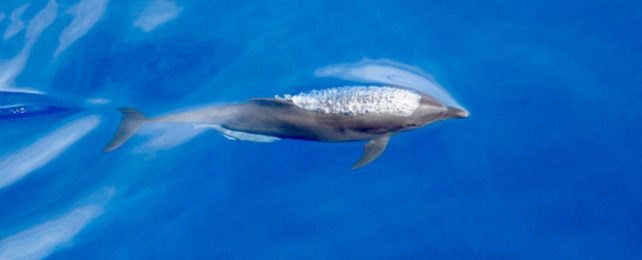The common bottlenose dolphin is one of the most well-studied marine mammals in the world. Yet in the last few decades, genetic research has revealed scientists aren't looking at a single species after all, but various lineages still very much in the process of evolving.
Researchers at the University of Miami have split what was historically thought to be one dolphin species (Tursiops truncatus) in the Pacific Ocean into a few distinct subtypes.
In the offshore waters of the Eastern Tropical Pacific (ETP), between Baja California and the Galapagos, bottlenose dolphins show distinctly smaller skulls and bodies than those off the coast of southern California or Japan.
Scientists argue these findings are strong enough evidence that ETP dolphins should be considered a separate subspecies.
"The distinct environmental conditions in the ETP may be driving the evolutionary differentiation of these bottlenose dolphins," the authors write.
"Given these results, we here recommend the recognition of ETP offshore bottlenose dolphins as a distinct subspecies, Tursiops truncatus nuuanu."
Bottlenose dolphins are found in ocean waters around the globe, and yet the way these mammals have adapted to certain coastline habitats has led to an incredible amount of physiological and genetic diversity over time.
The lineage of common bottlenose dolphins that live further offshore, for instance, seem to have evolved later than their closer-to-shore relatives.
Despite the fact that scientists suspect there are many overlooked subspecies, very few have been identified to date.
In fact, the Black Sea bottlenose dolphin (T. ponticus) and Lahille's bottlenose dolphin (T. gephyreus), found off Brazil's shore, are the only two that have been officially set apart.
In the eastern Pacific, bottlenose dolphins occupy a particularly varied waterscape, and these differing habitats may have led dolphin populations to evolve in separate directions, branching off from one another physically and genetically.
A 2020 study on the genetics of bottlenose dolphins in the estuaries of Ecuador, for instance, strongly suggests there are other neglected dolphin lineages out there that need to be classified separately.
When researchers at the University of Miami analyzed 135 bottlenose dolphin skulls, collected from all over the Pacific, they, too, noticed a branch in the dolphin family tree near Ecuador. But this one was further offshore.
Today, it's generally accepted that bottlenose dolphins in the northern temperate Pacific and bottlenose dolphins off the southern coast of California each represent a unique ecotype, which is a distinct grouping shaped by its local ecosystem. Claims that these changes represent distinct subspecies, however, remain controversial.
Dolphins swimming further south, in the ETP, have been comparatively overlooked. Because this population frequents deeper waters, further off the coast of South America, they have not been studied nearly as much, and their degree of differentiation is largely unknown.
Based on the current skull analysis, researchers argue ETP dolphins are, in fact, unique.
They are some of the smallest bottlenoses ever identified, on par with another possible species called Tamanend's bottlenose dolphin (T. erebennus), found in the western North Atlantic.
The small skull and body size probably came about based on what the mammals prefer to eat and how warm their habitat is.
ETP bottlenose dolphins, for instance, feed mostly on squids and small fish, and even though they live offshore and hunt in deeper waters, the ocean they swim in is still warmer than along the Californian coast, where cold currents flow.
A small body size suits this environment nicely, as it allows for heat to be shed more efficiently.
Interestingly, researchers in Miami also noticed some subtle morphological differences in bottlenose dolphins living off the coast of California. Those swimming closer to shore in the Gulf of California had a slightly different appearance to those living further offshore.
The contrast wasn't quite as stark as for the ETP dolphins, but the authors say these two populations in California may be in the early stages of splitting apart.
Further genetic studies are needed to confirm these results, but in all probability, common bottlenose dolphins have less in common than scientists once thought.
"Sightings of bottlenose dolphins also continue south of the ETP, into the eastern South Pacific (ESP), where further coastal and offshore ecotypes have been recognized," the authors write.
Maybe we will find more subspecies further south.
The study was published in the Journal of Mammalian Evolution.
